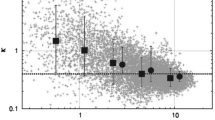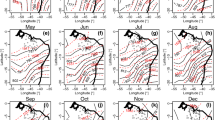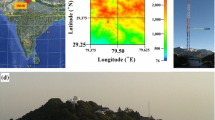Abstract
Detailed wind velocity profiles were obtained by means of a rocket-sonde technique to a height of about 700 m at a site in the Canadian Northwest Territories. Less detailed temperature observations were also made using a balloon sonde. The site was some 100 km east of the easternmost range of the Rocky Mountains. The observations took place in mid-February when the overall atmospheric static stability was considerable.
The results showed the presence of an arctic, atmospheric ‘thermocline’ some 500 m above ground, which sloped up or down considerably, with the generators of isothermal surfaces usually parallel to the nearby mountains, in the manner of upwelled or downwelled thermoclines in the ocean near shore. There was often strong baroclinic flow parallel to the mountain range. Noticeable frictional effects were confined to a near-ground layer always less than 100 m and mostly no more than 10 m in height. An Ekman-type boundary layer could only be identified in about one-third of the velocity profiles. The non-dimensionalized depth coefficient of such layers was close to 0.1, the geostrophic drag coefficient about 2.5×10−4.
Similar content being viewed by others
References
Benson, C. S.: 1970, ‘Ice Fog’,Weather 25, 11–18.
Burns, B. M.: 1973, ‘The Climate of the Mackenzie Valley — Beaufort Sea’, Climatological Studies No. 24, Atmospheric Environment Service, Toronto, 227 pp.
Csanady, G. T.: 1972, ‘The Coastal Boundary Layer in Lake Ontario,J. Phys. Oceanogr. 2, 41–53 and 168–176.
Csanady, G. T.: 1974, ‘Equilibrium Theory of the Planetary Boundary Layer with an Inversion Lid’,Boundary-Layer Meteorol. 6, 63–79.
Csanady, G. T. and Pade, B.: 1974, ‘Planetary Boundary Layer Studies in the Mackenzie Valley’, WRI Report, Project 3066, Univ. of Waterloo, Ontario.
Csanady, G. T. and Scott, J. T.: 1974, ‘Baroclinic Coastal Jets in Lake Ontario During IFYGL’,J. Phys. Oceanogr. 4, 524–541.
Dalrymple, P. C., Lettau, H. H. and Wollaston, S. H.: 1966, ‘South Pole Micrometeorology Program: Data Analysis’, in M. J. Rubin (ed.),Studies in Antarctic Meteorology, pp. 13–57, American Geophysical Union.
Lettau, H. H.: 1967, ‘Small to Large-Scale Features of Boundary Layer Structure over Mountain Slopes’, Proc. Symp. on Mountain Meteorology, Colorado State Univ., Colo., U.S.A.
Schwerdtfeger, W.: 1971, ‘Remarkable Wind Shifts and Speeds a Few Meters Above the Surface of the Antarctic Plateau’,Antarctic J.U.S. 6, 218–219.
Venkatesh, S. and Csanady, G. T.: 1974, ‘A Baroclinic Planetary Boundary Layer Model and its Application to the Wangara Data’,Boundary-Layer Meteorol. 5, 459–473.
Woods, J. D.: 1968, ‘Wave Induced Shear Instability in the Summer Thermocline’,J. Fluid Mech. 32, 791–800.
Yap, D.: 1974, ‘A Preliminary Investigation of Winter Air Pollution at Fort Simpson, Northwest Territories’,Atmosphere 12, 62–48.
Author information
Authors and Affiliations
Rights and permissions
About this article
Cite this article
Csanady, G.T., Pade, B. A planetary boundary-layer study in the Mackenzie Valley, Canada. Boundary-Layer Meteorol 8, 261–280 (1975). https://doi.org/10.1007/BF02153553
Received:
Issue Date:
DOI: https://doi.org/10.1007/BF02153553




